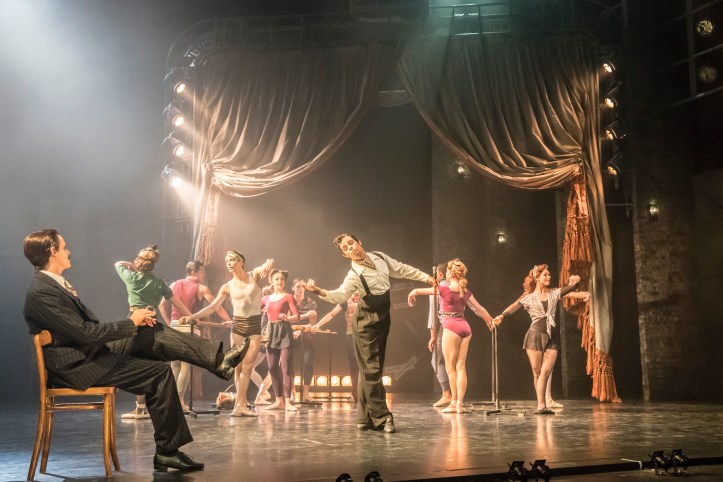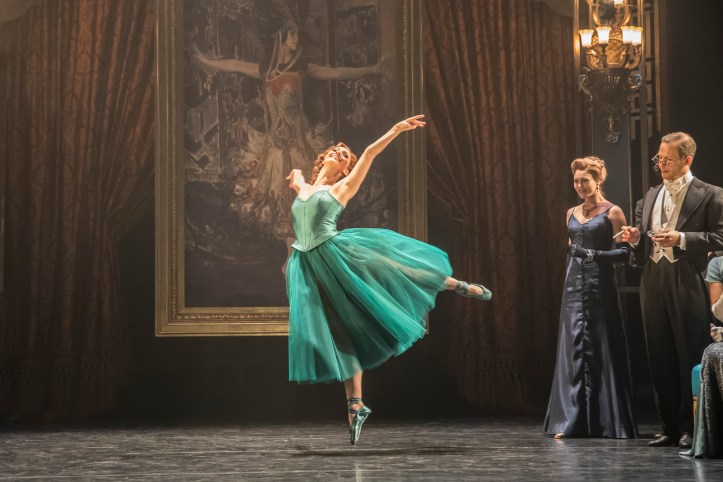
Matthew Bourne’s The Red Shoes: To Dance or To Love, The Choice is in the Shoes.
To many, including the likes of Martin Scorsese, Brian De Palma, and my goddess of song, Kate Bush (who created an album called “The Red Shoes“, inspired by this film), the Oscar winning 1948 British film, “The Red Shoes”, written, directed, and produced by Michael Powell and Emeric Pressburger is the quintessential ballet film. The sumptuous movie famously explores the obsessive love of ballet tragically crashing up against the desire of romantic love and companionship. Powell and Pressburger magnificently push the limits of filming in Technicolor’s three-strip process, especially noteworthy during the signature dance sequence using a bold, fluorescent-lit color palette. It’s not surprising that Sir Matthew Bourne, the famed wild child of the British ballet world, using his three decade old dance company, New Adventures, was also caught in the film’s magical vision and decided to take on the compelling task of adapting the film into a full length ballet. As the movie was more of a backstage melodrama with very little dance sequences, Bourne’s greatest challenge (well, one of many) was to turn this love triangle and career struggle into a sumptuous two-act ballet, with barely a word spoken between the dramatic characters. And somehow, against all odds, he miraculously succeeds giving us an elegant backstage drama, centered on the incompatibility of having a romantic love life and a celebrated dance career all at the same time. Much like the Hans Christian Andersen’s tale that this ballet is loosely based on, one has to suffer and give up one in order to have success in the other.

Being a theater-junkie at the ballet, much like a few days prior when I saw the opera, Dolores Claiborne by the New York City Opera, I found myself at a slight disadvantage. Asked by the lady sitting next to me if I reviewed dance and ballet, I had to acknowledge that I rarely even went to see dance, preferring spoken or sung dialogue to a physical expression of storytelling. She didn’t seem to be impressed with my answer, wondering how I could adequately write about this particular ballet, knowing so little. My answer is as with all things I review, be it movies, dance, opera, performance, and even theater: I always try to write from my emotional experience and gut reaction. For me, this is a valid position, and also extremely relevant to all those other non-dance aficionados who watch and sit in the same position as I do when we try stretch our minds and go to places outside our comfort zone. So here at the New York City Center, I found myself in the position of experiencing something new. For one, I found myself perpetually craving dialogue or some musical lyrics to enhance the emotional connection (I was not going to get nary a word spoken), and unable to really create a critical discussion of the technical aspects of the dancer and the dance. I am able to register how it effects my soul, what it is like to fully embrace the storytelling process, to find myself reveling in the strong love physicalized, and in the immensely satisfying theatrics on display.

It all starts with a beautiful proscenium within the proscenium. The magnificent set piece created by set designer Lez Brotherston (New Adventures’ associate artist, Royal Ballet’s Seven Deadly Sins) is complete with a dark red curtain and antique fixtures. It rolls back and forth and rotates majestically, offering us numerous interesting and unconventional vantage points to view both the front and backstage drama. Bourne’s The Red Shoes is set in the late 1940’s and early 1950’s, just like the movie version, transporting us from London to Monte Carlo and Villefranche-sur-Mer. After an initial introduction to the stylized front and back of house vantage points, we are ushered into a post performance cocktail party where the guests dance a wonderfully funny and bored waltz. The young and hopeful ballet dancer, Victoria Page, performed at this performance by Ashley Shaw (New Adventure’s Sleeping Beauty), tries desperately to make an impression to all those present, especially the ballet impresario, Boris Lermontov, portrayed by the skilled dancer and actor, Sam Archer (New Adventure’s Lord of the Flies). Her beautiful solo for the guests, a change from the film version, earns her a chance to rehearse on the maestro’s latest ballet. Through a literal twist of fate, the prima ballerina, Irina Boronskaya, played by the regal looking Michela Meazza (New Adventure’s Cinderella), falls and twists her ankle, giving Victoria her chance to dance the lead. This is a dramatic but more simplistic alteration from the film. Powell and Pressburger created a parallel conflict, having Irina voluntarily make a choice between continuing as the company’s prima ballerina and a marriage that would end her career. Clearly this plot point foreshadows the commitment and decision Victoria is going to face moving forward, but I’m getting ahead of myself.

Lermontov, overjoyed with Victoria and her performance commissions composer Julian Craster, portrayed exquisitely by the magnificent and handsome Marcelo Gomes (principle dancer at the American Ballet since 2002), to compose a ballet based on the dense Hans Christian Andersen’s tale, “The Red Shoes” strictly for Victoria. This ballet within the ballet has to be one of the most stunningly stylistic moments of the entire evening. The sumptuous ballet that Bourne creates as the pivotal centerpiece, with Victoria dancing the lead, is gorgeously choreographed, but the dramatic decision to rid the stage of the ornate proscenium utilized throughout, discard the old-movie color schemes, and fly large white stage frames into place is breath-taking. The stage is now set for a dramatically different monochromatic piece where all is in beautiful black and white, the complete opposite to the color treatment that was famously utilized in the 1948 film. The costumes, except for the red shoes and the crimson pinstripes of the wicked Shoemaker’s suit, the devil-like man who offers the magical shoes to the girl, against the stark white proscenium frames, perfect for the wonderfully moody projections, are all spectacular. Designed by Brotherston, who truly outdoes himself here, uses the simplistic space to accentuate the dancers’ stylistic movements as they saunter and dance there way across and about the space, reminding me of the inventive dance numbers by Bob Fosse in his epic film, All That Jazz, and that one spectacular number, “The Rich Man’s Frug” in his Sweet Charity movie.

The curtain comes down on the commissioned “The Red Shoes” and Lermontov, eager to congratulate Victoria on her success, comes crashing into the sight of Craster and Victoria passionately embracing as the applause lingers on. These two have fallen in love, and Lermontov is devastated. Act One comes to a dramatic end as he looks on, and we see and feel how this moment is the pivotal moment when Victoria will be forced to choose between love and career. The only problem with Act One is that a few of the events and love relationships are not developed acutely enough to fully register, and therefore lose some of their power. Maybe it was because I had a hard time following Lermontov and didn’t see his growing infatuation with Victoria, thus making the climatic moment not as devastating. Only in the last minute of Act One did I realize that his heart was at risk, and therefore her career was as well.
Act Two showcases the aftermath of Victoria’s decision and is completely brisk and exhilarating. And as in the Hans Christian Anderson’s fairy tale, her choice is made the moment Victoria slips on the red shoes, for it is then that we see what she values the most, and we all know that this can’t end well. In the fairy tale, the dancer, unable to unlace the red shoes, is danced to exhaustion and death, and while in The Red Shoes, they don’t have that same magical power, the obsession is as deadly as ever. In The Red Shoes, love and career are incompatible. In order to achieve greatness, a dancer must choose between them.
Matthew Bourne’s ballet is a triumph for the heart and soul, with every moment perfectly visualized and elevated by artful design ideas and detailed styling. Bourne’s choreography is executed with an exacting approach to style, gracefulness, emotionality, dramatic storytelling, and witty and thoughtful characterizations, all orchestrated with the lightest of touches. He manages to weave in visual cues and references to the film, with also a ‘tip of the hat’ (thank you Seth Rudetsky for that phrase I’m borrowing) to old Hollywood movies from the same era. The music chosen is mesmerizing, feeling incredibly original while also fitting to the ballet’s 1948 film origin. It comes as no great surprise (although I am amazed by the inventive idea) that the score belongs to the great screen composer Bernard Herrmann (1911-75). Herrmann is most famously known for his collaborations with director Alfred Hitchcock, creating the scores for such classics as “Psycho”, “North by Northwest”, “The Man Who Knew Too Much”, and “Vertigo”. He also composed scores for many other movies, including “The Day the Earth Stood Still”, “Cape Fear”, and “Taxi Driver”. Bourne handpicked music from a number of his well-known film scores such as the great “Citizen Kane,” “The Ghost and Mrs. Muir,” and “Fahrenheit 451” to weave one solid musical story together flawlessly. The transcribing of these pieces accentuates the period and the celluloid connection giving this production a feeling of unity and one-ness from beginning to end. Without a doubt, The Red Shoes is considered by many to be one of Bourne’s finest achievements to date, winning him the Best Theatre Choreographer and the Best Entertainment at the 2017 Olivier Awards. Having seen only one other Bourne piece, the All male Swan Lake on Broadway years ago, I heartedly, albeit amateurishly agree. It’s a performance piece worthy for all to see.
[…] Being a theater-junkie at the ballet, much like a few days prior when I saw the opera, Dolores Claiborne by the New York City Opera, I found myself at a slight disadvantage. Asked by the lady sitting next to me if I reviewed dance and ballet, I had to acknowledge that I rarely even went to see dance, preferring spoken or sung dialogue to a physical expression of storytelling. She didn’t seem to be impressed with my answer, wondering how I could adequately write about this particular ballet, knowing so little. My answer is as with all things I review, be it movies, dance, opera, performance, and even theater: I always try to write from my emotional experience and gut reaction. For me, this is a valid position, and also extremely relevant to all those other non-dance aficionados who watch and sit in the same position as I do when we try stretch our minds and go to places outside our comfort zone. So here at the New York City Center, I found myself in the position of experiencing something new. For one, I found myself perpetually craving dialogue or some musical lyrics to enhance the emotional connection (I was not going to get nary a word spoken), and unable to really create a critical discussion of the technical aspects of the dancer and the dance. I am able to register how it effects my soul, what it is like to fully embrace the storytelling process, to find myself reveling in the strong love physicalized, and in the immensely satisfying theatrics on display. (for the full review, click here) […]
LikeLike
[…] to the compelling images that take us back in time, courtesy of projection designer Duncan McLean (Matthew Bourne’s The Red Shoes at City Center). It elevates the crowd, bringing them to their feet to dance to the music and feel […]
LikeLike